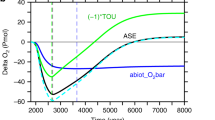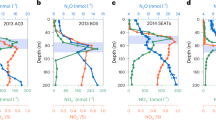Abstract
Over geological time, photosynthetic carbon fixation in the oceans has exceeded respiratory oxidation of organic carbon. The imbalance between the two processes has resulted in the simultaneous accumulation of oxygen in, and drawdown of carbon dioxide from, the Earth's atmosphere, and the burial of organic carbon in marine sediments1–3. It is generally assumed that these processes are limited by the availability of phosphorus4,5, which is supplied by continental weathering and fluvial discharge5–7. Over the past two million years, decreases in atmospheric carbon dioxide concentrations during glacial periods correlate with increases in the export of organic carbon from surface waters to the marine sediments8–11, but variations in phosphorus fluxes appear to have been too small to account for these changes12,13. Consequently, it has been assumed that total oceanic primary productivity remained relatively constant during glacial-to-interglacial transitions, although the fraction of this productivity exported to the sediments somehow increased during glacial periods12,14. Here I present an analysis of the evolution of biogeochemical cycles which suggests that fixed nitrogen, not phosphorus, limits primary productivity on geological timescales. Small variations in the ratio of nitrogen fixation to denitrification can significantly change atmospheric carbon dioxide concentrations on glacial-to-interglacial timescales. The ratio of these two processes appears to be determined by the oxidation state of the ocean and the supply of trace elements, especially iron.
This is a preview of subscription content, access via your institution
Access options
Subscribe to this journal
Receive 51 print issues and online access
$199.00 per year
only $3.90 per issue
Buy this article
- Purchase on Springer Link
- Instant access to full article PDF
Prices may be subject to local taxes which are calculated during checkout
Similar content being viewed by others
References
Berner, R. A. A model for atmosphereic CO2 over the Phanerozoic. Am. J. Sci. 291, 339–376 (1991).
Holland, H. D. The Chemical Evolution of the Atmosphere and Oceans (Princeton Univ. Press, Princeton, 1984).
Walker, J. C. G. Was the Archaean Biosphere upside down? Nature 329, 710–712 (1987).
Redfield, A. C. The biological control of chemical factors in the environment. Am. Sci. 46, 205–221 (1958).
Broecker, W. S. Glacial to interglacial changes in ocean chemistry. Prog. Oceanogr. 11, 151–197 (1982).
Meybeck, M. Carbon, nitrogen, and phsophorus transport by world rivers. Am. J. Sci. 282, 401–450 (1982).
Froelich, P. N. Kinetic control of dissolved phosphate in natural rivers and estuaries: a primer on the phosphate buffer mechanism. Limnol. Oceanogr. 33, 649–668 (1988).
Mix, A. C. Influence of productivity variations on long-term atmospheric CO2 . Nature 337, 541–544 (1989).
Sarnthein, M., Winn, K., Duplessy, J.-C. & Fontugne, M. R. Global variations of surface ocean primary productivity in low and mid latitudes: influence on CO2 reservoirs of the deep ocean and atmosphere during the last 21,000 years. Paleoceanography 3, 361–399 (1988).
Lyle, M. W., Prahl, F. G. & Sparrow, M. A. Upwelling and productivity changes inferred from a temperature record in the central equatorial Pacific. Nature 355, 812–815 (1992).
Bender, M. & Sowers, T. The Dole effect and its variations during the last 130,000 years as measured in the Vostok ice core. Global Biogeochem. Cycles 8, 363–376 (1994).
Boyle, E. A. The role of vertical chemical fractionation in controlling late quaternary atmospheric carbon dioxide. J. Geochem. Res. 93, 15701–15714 (1988).
Imbrie, J. et al. On the structure and origin of major glaciation cycles. I. Linear responses to Milankovitch forcing. Paleoceanography 7, 701–738 (1992).
Archer, D. & Maier-Reimer, E. Effect of deep-sea sedimentary calcite preservation on atmospheric CO2 concentration. Nature 367, 260–263 (1994).
Broecker, W. S., Peng, T.-H. & Engh, R. Modeling the carbon system. Radiocarbon 22, 565–598 (1980).
Barber, R. T. in Primary Productivity and Biogeochemical Cycles in the Sea (eds Falkowski, P. G. & Woodhead, A.) 89–106 (Plenum, New York, 1992).
Kasting, J. F. Bolide impacts and the oxidation state of carbon in the Earth's early atmosphere. Origins Life Evol. Biosphere 20, 199–231 (1990).
Warneck, P. Chemistry of the Natural Atmosphere (Academic, New York, 1988).
Postgate, J. R. Nitrogen Fixation (Edward Arnold, London, 1987).
Zehr, J. P. et al. Diversity of heterotrophic nitrogen-fixation genes in a marine cyanobacterial mat. Appl. Environ. Microbiol. 61, 2527–2532 (1995).
Van Cappellen, P. & Ingall, E. D. Redox stabilization of the atmosphere and oceans by phosphorus-limited marine productivity. Sceince 271, 493–496 (1996).
Berner, R. A. Early Diagenesis, a Theoretical Approach (Princeton Univ. Press, Princeton, 1980).
Stumm, W. & Morgan, J. J. Aquatic Chemistry (Wiley, New York, 1981).
Copin-Montegut, C. & Copin-Montegut, G. Stoichiometry of carbon, nitrogen and phosphorus in marine particulate matter. Deep-Sea Res. 30, 31–46 (1983).
Letelier, R. M. & Karl, D. M. The role of Trichodesmium spp. in the productivity of the subtropical North Pacific Ocean. Mar. Ecol. Prog. Ser. 133, 263–273 (1996).
Kaplan, W. A. in Nitrogen in the Marine Environment (eds Carpenter, E. J. & Capone, D. G.) 139–190 (Academic, New York, 1983).
Christensen, J. P., Murray, J. W., Devol, A. H. & Codispoti, L. A. Denitrification in continental shelf sediments has major impact on the oceanic nitrogen budget. Global Biogeochem. Cycles 1, 97–116 (1987).
Codispoti, L. A. & Christensen, J. P. Nitrification, denitrification and nitrous oxide cycling in the eastern tropical south Pacific Ocean. Mar. Chem. 16, 277–300 (1985).
Devol, A. H. Direct measurement of nitrogen gas fluxes from continental shelf sediments. Nature 349, 319–321 (1991).
Seitzinger, S. Denitrification in freshwater and coastal marine ecosystems: ecological and geochemical importance. Limnol. Oceanogr. 33, 702–724 (1988).
Zumpft, W. G. in The Prokaryotes: A Handbook on the Biology of Bacteria: Ecophysiology, Isolation, Applications (eds Ballow, A, Truper, H. G., Dworkin, M., Harder, W. & Schleifer, K.-H.) 554–582 (Springer, New York, 1992).
Krom, M. D., Kress, N., Brenner, S. & Gordon, L. I. Phosphorus limitation of primary productivity in the eastern Mediterranean Sea. Limnol. Oceanogr. 36, 424–432 (1991).
Martin, J. H. in Primary Productivity and Biogeochemical Cycles in the Sea (eds Falkowski, P. & Woodhead, A.) 123–137 (Plenum, New York, 1992).
Rhther, J. H. & Dunstan, W. M. Nitrogen, phsophorus, and eutrophication in the coastal marine environment. Science 171, 1008–10013 (1971).
Dugdale, R. C. Nutrient limitation in the sea: dynamics, identification, and significance. Limnol. Oceanogr. 12, 685–695 (1967).
McElroy, M. B. Marine biological controls on atmospheric CO2 & climate. Nature 302, 328–329 (1983).
Fanning, K. A. Nutrient provinces in the sea: concentration ratios, reaction rate ratios, and ideal covariation. J. Geophys. Res. 97C, 5693–5712 (1992).
Anderson, L. A. & Sarmiento, J. L. Redfield ratios of remineralization determined by nutrient data analysis. Global Biogeochem. Cycles 8, 65–80 (1994).
Codispoti, L. A. Is the ocean losing nitrate? Nature 376, 724 (1995).
Carpenter, E. J. & Romans, K. Major role of the cyanobacterium Trichodesrnium in nutrient cycling in the North Atlantic Ocean. Science 254, 1356–1358 (1991).
Carpenter, E. J. & McCarthy, J. J. Nitrogen fixation and uptake of combined nitrogenous nutrients by Oscillatoria (Trichodesmium) thiebautii in the western Sargasso Sea. Limnol. Oceanogr. 20, 389–401 (1975).
Raven, J. A. The iron and molybdenum use efficiencies of plant growth with different energy, carbon and nitrogen sources. New Phytol. 109, 279–287 (1988).
Williams, R. J. P. Natural selection of the elements. Proc. R. Soc. Lond. B213, 361–397 (1981).
Falkowski, P. G. & Raven, J. A. Aquatic Photosynthesis (Blackwell, Oxford, 1997).
Duce, R. A. & Tindale, N. W. Atmospheric transport of iron and its deposition in the ocean. Limnol. Oceanogr. 36, 1715–1726 (1991).
Carpenter, E. J. in Nitrogen in the Marine Environment (eds Carpenter, E. J. & Capone, D. G.) (Academic, New York, 1983).
Reuter, J. G. J. Theoretical Fe limitations of microbial N2 fixation in the oceans. Eos 63, 445 (1982).
Howarth, R. W., Marino, R. & Cole, J. J. Nitrogen fixation in freshwater, estuarine, & marine ecosystems. 2. Biogeochemical controls. Limnol. Oceanogr. 33, 688–701 (1988).
Martin, J. H. et al. Testing the iron hypothesis in the Equatorial Pacific. Nature 371, 123–129 (1994).
Kolber, Z. S. et al. Iron limitation of phytoplankton photosynthesis in the Equatorial Pacific Ocean. Nature 371, 145–149 (1994).
Behrenfeld, M., Bale, A., Kolber, Z., Aiken, J. & Falkowski, P. G. Confirmation of iron limitation of phytoplankton photosynthesis in the equatorial Pacific Ocean. Nature 383, 508–511 (1996).
Herguerra, J. C. & Berger, W. H. Glacial to postglacial drop in productivity in the western equatorial Pacific: mixing rate vs. nutrient concentration. Geology 22, 629–632 (1994).
Ganeshram, R. S., Pedersen, T. F., Calvert, S. E. & Murray, J. W. Large changes in oceanic nutrient inventories from glacial to interglacial periods. Nature 376, 755–758 (1995).
Altabet, M. A., Francois, R., Murray, D. W. & Prell, W. L. Climate-related variations in denitrification in the Arabian Sea from sediment 15N/14N ratios. Nature 373, 506–509 (1995).
Sarmiento, J. & Orr, J. Three-dimensional simulations of the impact of Southern Ocean nutrient depletion on atmospheric CO2 and ocean chemistry. Limnol. Oceanogr. 36, 1928–1950 (1991).
Peng, T.-H. & Broecker, W. S. Factors limiting the reduction of atmospheric CO2 by iron fertilization. Limnol. Oceanogr. 36, 1919–1927 (1991).
Raynaud, D. et al. The ice record of greenhouse gases. Science 259, 926–934 (1993).
Dickson, A. G. & Millero, F. W. A comparison of the equilibrium constant for the dissociation of carbonic acid in seawater media. Deep-Sea Res. 34, 1733–1743 (1987).
Carpenter, E. J. & Capone, D. G. in Marine Pelagic Cyanobacteria: Trichodesrnium and Other Diazotrophs (eds Carpenter, E. J., Capone, D. G. & Rueter, J. G.) 211–217 (Academic, Dordrecht, 1992).
Gruber, N. & Sarmiento, S. L. Global patterns of marine fixation and denitrification revealed by the conservative tracer N*. Global Biogeochem. Cycles (in the press).
Farrell, J. W., Pedersen, T. F., Calvert, S. E. & Nielsen, B. Glacial-interglacial changes in nutrient utilization in the equatorial Pacific Ocean. Nature 377, 514–517 (1995).
Berger, A. Milankovitch theory and climate. Rev. Geophys. 26, 624–657 (1988).
Shaffer, G. A non-linear climate oscillator controlled by biogeochemical cycling in the ocean: an alternative model of Quaternary ice ages cycles. Clim. Dyn. 4, 127–143 (1990).
Hutchinson, G. E. A Treatise on Limnology (Wiley, New York, 1957).
Broecker, W. S. & Peng, T.-H. Tracers in the Sea (Eldigo Press, Lamont-Doherty Geological Observatory, New York, 1982).
Codispoti, L. A. in Productivity of the Ocean: Present and Past (eds Berger, W. H., Smetacek, V. S. & Wefer, G.) 377–394 (Wiley, New York, 1989).
Paytan, A., Kastner, M. & Chavez, F. P. Glacial to interglacial fluctuations in productivity in the equatorial Pacific as indicated by marine barite. Science 274, 1355–1357 (1996).
Sarmiento, J. L. & Le Quéré, C. Oceanic carbon dioxide uptake in a model of century-scale global warming. Science 274, 1346–1350 (1996).
Michaels, A. F. et al. Inputs, losses and transformations of nitrogen and phosphorus in the pelagic North Atlantic Ocean. Biogeochemistry 35, 181–226 (1996).
Author information
Authors and Affiliations
Rights and permissions
About this article
Cite this article
Falkowski, P. Evolution of the nitrogen cycle and its influence on the biological sequestration of CO2 in the ocean. Nature 387, 272–275 (1997). https://doi.org/10.1038/387272a0
Received:
Accepted:
Issue Date:
DOI: https://doi.org/10.1038/387272a0
This article is cited by
-
Direct biological fixation provides a freshwater sink for N2O
Nature Communications (2023)
-
Hydrodynamic regimes modulate nitrogen fixation and the mode of diazotrophy in Lake Tanganyika
Nature Communications (2023)
-
Ambiguous controls on simulated diazotrophs in the world oceans
Scientific Reports (2022)
-
Transcriptional responses of Trichodesmium to natural inverse gradients of Fe and P availability
The ISME Journal (2022)
-
Microbially facilitated nitrogen cycling in tropical corals
The ISME Journal (2022)
Comments
By submitting a comment you agree to abide by our Terms and Community Guidelines. If you find something abusive or that does not comply with our terms or guidelines please flag it as inappropriate.



